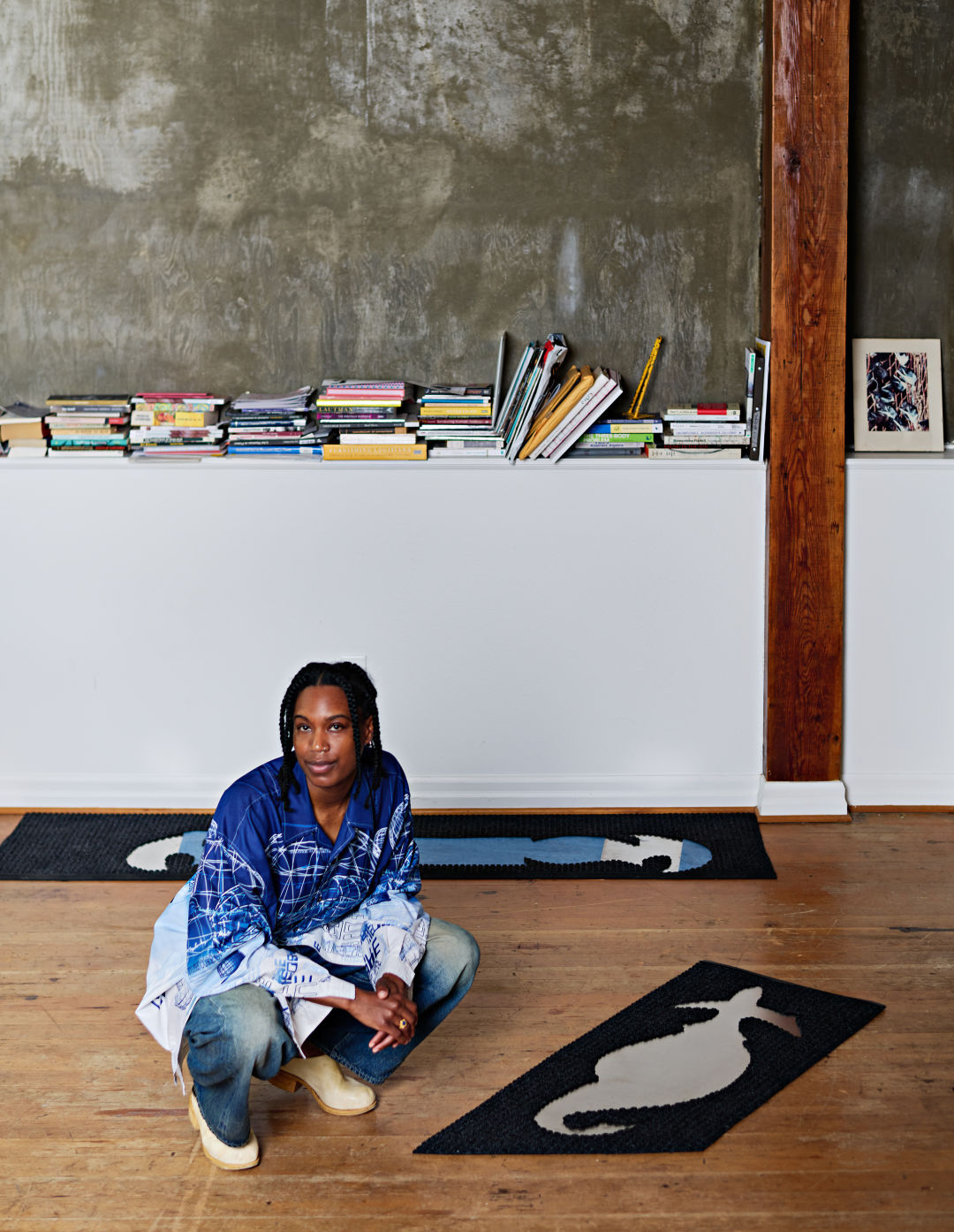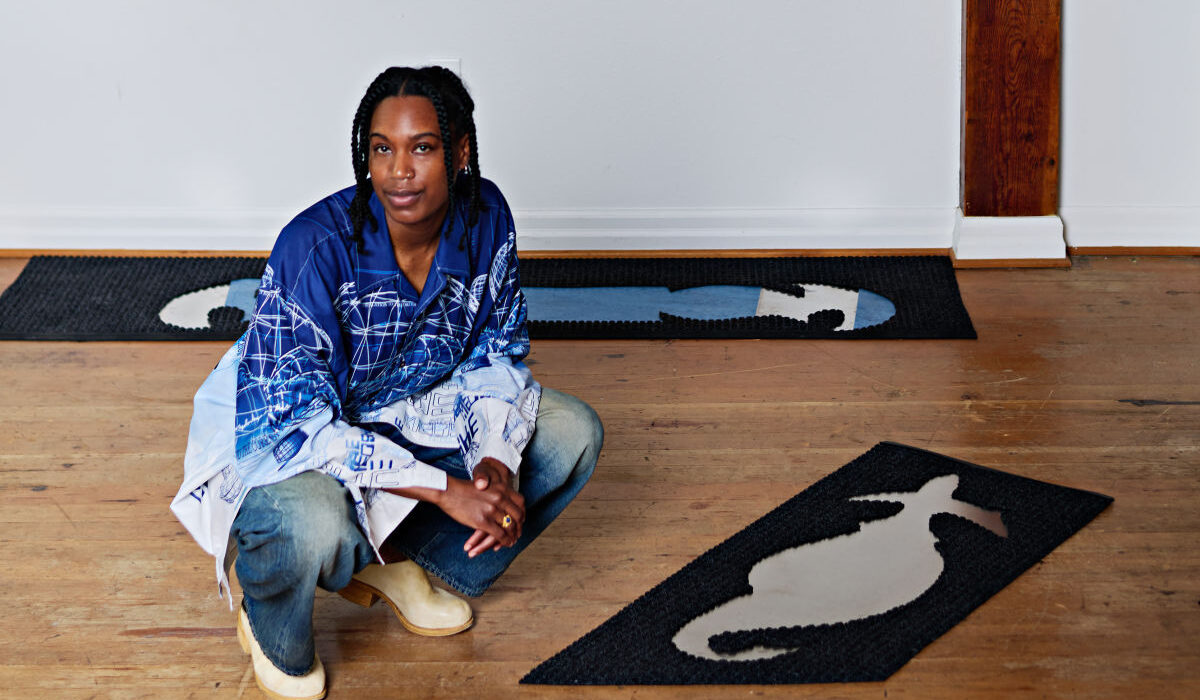
O’Neal at their Portland studio.
The Portland artist and math scholar Sidony O’Neal recently wrote an essay on the word “equation.” It appears in an upcoming anthology from the Practicing Refusal Collective, an international Black feminist group of artists and scholars. O’Neal’s essay investigates the functions of a mathematical equal sign: how, when two variables are set on either side of it, they may as well be the same; how it doesn’t matter what they were before. An equation, O’Neal told me, is a verb, “a doing” that’s liable to call something “fungible where it isn’t.”
O’Neal is an artist of ideas, but an artist still. They’re known for abstract sculpture and drawings made from an impressively far-flung list of materials, including plastic swimming pool ladders and something called vapor-smoothed TPU-70A. The titles—in-jokes and references to coding, mathematics, philosophy, and art theory—signal the breadth of the artist’s influences. It’s easy to see these stacks of information as riddles, equations to understand (with a lot of Googling). Why ornament an industrial plastic pallet with 3-D-printed and machined metal sculptures? Why incorporate forms from fifteenth-century locking mechanisms into swirling, delicate pencil drawings? There are ideas to trace. But O’Neal is an artist, not a theorist. If asked, they wouldn’t offer any of these physical pieces alone as a representation of their work. Their primary medium, over sculpture or drawing or writing, is research.
Their focus is the fertile ground between artistic and mathematical concepts, materials and forms. The works are almost notes on their explorations. They study the way a key interacts with a lock and isolate that relationship in a new context, or remove it from context altogether. For the viewer, it presents a new perspective on interaction. “If I’m a conceptual artist,” they told me, “the things I’m making or offering are really robust tools.”
O’Neal, 35, grew up in South Sacramento, California, one of six kids. Their father brought a global perspective home from military travels, and languages came easy: French and Spanish in school, Japanese on weekends. Math, especially where it intersects with art, has always fascinated them, despite authority figures and institutions saying, What intersection? “Who knows if you can be an artist and a mathematician,” O’Neal says.
In 2007, they moved to Portland to attend Reed College, where the math and art classes were scheduled at the same time. They settled on linguistics—math and art are both languages, after all. They never finished a degree (which hasn’t kept them from regularly lecturing at universities today) but held onto that linguistic lens.
O’Neal with two prototype versions of their “floor intervention” sculptures, which stretch and recontextualize patterns borrowed from ancient locking mechanisms.
O’Neal likes to layer seemingly unrelated schools of thought that share a name. For example: constructivism, the early-twentieth-century artistic movement that reflected society by making art from found objects and modern technologies, and constructivist mathematics, a philosophy that doesn’t rely on classical theoretical proofs to show something exists.
“It seems like such a simple ruse, right?” O’Neal says. “To be like, ‘This word is used in this context, and also in this context.’” But it’s proven effective at forging new relationships, or “interfaces,” as the artist likes to call these experimental pairings.
O’Neal was awarded a research fellowship at Princeton University to investigate links between the two constructivisms. The pallet sculpture mentioned above, Program for fireback with sacrificial anode, came out of that research. “Conceptually, it’s anchored in [trying to] visualize a computer program,” they told me. “Computers are very literal machines. They need to be told how to build something.”
Program for fireback with sacrificial anode (2023) by Sidony O’Neal from The Pudding Butcher at the Lewis Center for the Arts at Princeton University.
Materially, the sculpture pulls from marine engineering (a sacrificial anode is a type of alloy that protects ships from saltwater erosion) and fireplace hardware (a fireback is a plate used to radiate heat). While not entirely literal, the sculpture physically and metaphorically maps a computer program, and it uses found objects and modern technologies to do so: constructivism squared.
O’Neal also likes to style their artist statements after mathematical proofs, which they call “a special form of literature.” It’s a rigid, narrative argument. O’Neal thinks of them as poems, interpretable and evocative. This reframing is an attempt, they say, at “disabusing math of belonging only to the realm of cold rationality.”
There are loads of rabbit holes to fall into. But to take the works’ precise, laser-cut aesthetic to mean they are making a specific point is to remove O’Neal’s artistry. No matter who you are and how much homework you do, O’Neal says, you can “walk into the gallery and not know what the fuck you’re looking at.” That’s no mistake. You don’t have to engage with or even fully comprehend their viewpoint. Instead, the works are a study of interface itself, with innumerable entry points, something you can use to look at the relationship
between objects—perhaps people—in the world.

